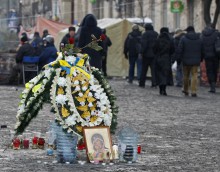The first fatalities of the Euromaidan could have been avoided. Furthermore, there could have been no killings at all during the Revolution of Dignity. Back at the beginning of the mass protests in the central square of the country, leader of the Norilsk Uprising that took place in the Gulag camps in 1953, Yevhen Hrytsiak, stressed the need for a peaceful, non-violent Euromaidan, drawing on his own experience of unarmed resistance to dictatorship which resulted in dismantling of the Gulag system and emergence of the dissident movement.
“I remember how people approached me in Karaganda and asked me to lead a Gulag-wide strike,” Hrytsiak emphasized in an interview with Den in December 2013. “Then I said it could not be done at once and offered to organize a strike in one particular camp first. I wanted to show that people could resist peacefully, without weapons. I counted on a subsequent chain reaction starting... Fortunately, it happened just that way. In all the camps of the Soviet Union, people went on strike. First Norilsk, then Vorkuta, followed by Kengir. I am extremely pleased that this chain of freedom has come to Kyiv. Finally! Today’s Euromaidan employs the same non-violent method of pressure, the method of civil disobedience. Trust me, no dictatorship can withstand this force. Never. I know it.”
But the peaceful Maidan protest overflowed its banks... On the Unity Day, January 22, 2014, two protesters were shot dead in Hrushevskoho Street, another found dead near Kyiv, and two more died of their wounds in hospital. The first death to become public knowledge was that of Serhii Nigoyan, a 20-year-old protester who arrived in Kyiv on January 8 from the Dnipropetrovsk oblast. He received three gunshot wounds to the head, neck, and chest.
Another activist who died in Hrushevskoho Street was Mikhail Zhiznevsky, a citizen of Belarus. He was 25 years old. Born in Belarus, he left for Ukraine in 2005 for political reasons. He lived and worked in Kyiv and Bila Tserkva. Zhiznevsky served in the Euromaidan guard from the first day. He was killed during clashes in Hrushevskoho Street, shot through his heart.
Also on January 22, 2014, it was reported that a mutilated corpse, with its head wrapped in tape, had been found in the Boryspil raion, Kyiv oblast. Relatives recognized the killed man as Yurii Verbytskyi. Verbytskyi had disappeared along with civic activist Ihor Lutsenko. As told later by Lutsenko who managed to survive, they had been kidnapped by a group of unidentified men directly from the doctor’s office where Lutsenko brought Verbytskyi for examination of an eye injury. According to Lutsenko, they were taken to a forest outside Kyiv and beaten there, then kept in a metal garage for a long time and questioned there. Verbytskyi came to the Maidan on January 20, he was 50 and held a Ph.D. degree in seismology.
Roman Senyk died on January 25 in hospital from wounds sustained in the regime forces’ assault on Hrushevskoho Street on January 22. The man was taken to hospital on January 22 with a wound to his chest; he was in shock and unconscious. Kyivites donated blood for the victim en masse, but the doctors failed to save his life. Senyk was 45 and resided in the village of Nakonechne-2, Lviv oblast.







